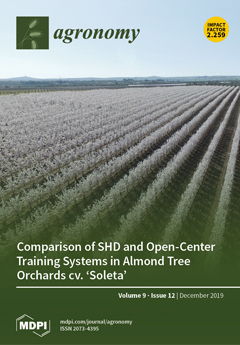To rapidly produce strawberry (
Fragaria ×
ananassa Duch. cv. Benihoppe) transplants from cuttings, suitable light intensities for unrooted runner plants at the rooting stage and rooted runner plants at the seedling stage were determined in a plant factory under LED lighting. At the rooting stage, unrooted runner plants at the 3-leaf stage were hydroponically rooted for 6 days under light intensity of 30, 90, 150, and 210 μmol m
−2 s
−1, respectively. At the seedling stage, rooted runner plants were hydroponically grown for 18 days under light intensity of 90, 180, 270, and 360 μmol m
−2 s
−1, respectively. The tube LED lights consisting of white and red LED chips were used as sole light source, and photoperiod was controlled as 16 h d
−1. The results showed that the maximum root number (7.7) and longest root length (14.8 cm) of the runner plants were found under 90 μmol m
−2 s
−1 at the rooting stage. Photosynthetic activity in runner plant leaves under 90 μmol m
−2 s
−1 were higher than that under 30, 150, and 210 μmol m
−2 s
−1. Higher light intensity at the range of 90–270 μmol m
−2 s
−1 increased the stomatal conductance of newly formed leaves of rooted runner plants, thus improving the net photosynthetic rate and growth of rooted runner plants at the seedling stage. The crown diameter, shoot and root dry weights, and root to shoot ratio of rooted runner plants increased by 9.7%, 38.8%, 106.1%, and 48.7%, respectively, when the light intensity increased from 90 to 270 μmol m
−2 s
−1. However, there was no further improvement of runner plant growth under 360 μmol m
−2 s
−1. Furthermore, no significant difference of increased dry biomass per mole of photons delivered was found between 180 and 270 μmol m
−2 s
−1. In consideration of transplant quality and economic balance, light intensity of 90 μmol m
−2 s
−1 at the rooting stage and 270 μmol m
−2 s
−1 at the seedling stage were suggested for rapidly producing hydroponic strawberry transplants based on unrooted runner plants in the LED plant factory.
Full article





